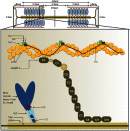The genetics of hypertrophic cardiomyopathy
- PMID: 30393648
- PMCID: PMC6209452
- DOI: 10.21542/gcsp.2018.36
The genetics of hypertrophic cardiomyopathy
Abstract
Hypertrophic cardiomyopathy (HCM) is most commonly transmitted as an autosomal dominant trait, caused by mutations in genes encoding cardiac sarcomere proteins1-3. Other inheritable causes of the disease include mutations in genes coding for proteins important in calcium handling or that form part of the cytoskeleton4-6. At present, the primary clinical role of genetic testing in HCM is to facilitate familial screening to allow the identification of individuals at risk of developing the disease7,8. It is also used to diagnose genocopies, such as lysosomal9-11 and glycogen storage disease which have different treatment strategies, rates of disease progression and prognosis12-14. The role of genetic testing in predicting prognosis is limited at present, but emerging data suggest that knowledge of the genetic basis of disease will assume an important role in disease stratification15-17 and offer potential targets for disease-modifying therapy in the near future18.
Figures


References
-
- Richard P, et al. Hypertrophic cardiomyopathy: distribution of disease genes, spectrum of mutations, and implications for a molecular diagnosis strategy. Circulation. 2003;107(17):2227–32. - PubMed
-
- Lopes LR, Rahman MS, Elliott PM. A systematic review and meta-analysis of genotype-phenotype associations in patients with hypertrophic cardiomyopathy caused by sarcomeric protein mutations. Heart. 2013;99(24):1800–11. - PubMed
-
- Erdmann J, et al. Mutation spectrum in a large cohort of unrelated consecutive patients with hypertrophic cardiomyopathy. Clin Genet. 2003;64(4):339–49. - PubMed
Publication types
LinkOut - more resources
Full Text Sources
